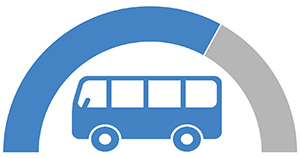Goal: Improve Mobility& Access to Services


About 66% of Strategic Sonoma Mobility Goals are completed or ongoing.
Measure of Success
- Commute Times
- Population Served by Public Transit Public Transit Ridership
- Hike/Bike Trail Mileage
- Transit-Oriented Development Square Footage
- Infrastructure Capital Investment
Collective Impact Partners
- Sonoma County Transit
- Sonoma County Transportation & Public Works
- Santa Rosa CityBus
- Sonoma County
- Local Cities
- Association of Bay Area Governments Metropolitan Transportation Commission Educational Institutions
- Private employers
- Ride-share companies
Objective: Sonoma County residents have access to affordable and safe multi-modal transit options ithin the county and connecting to the Bay Area.
 Transportation mobility is a fundamental need – allowing individuals to conduct a range of affairs outside the home, including commuting to work, shopping for groceries, accessing healthcare, attending school, and engaging in leisure activities. Psychological research shows additional links between mobility and well-being. People of all ages face mobility challenges, but younger and older people are often the most disadvantaged due to cost, access, and physical constraints. Addressing these challenges takes a number of forms such as reducing commute times for drivers, improving public transportation options, creating “Last Mile” solutions, and securing broadband internet connections to facilitate access to mobile services.
Transportation mobility is a fundamental need – allowing individuals to conduct a range of affairs outside the home, including commuting to work, shopping for groceries, accessing healthcare, attending school, and engaging in leisure activities. Psychological research shows additional links between mobility and well-being. People of all ages face mobility challenges, but younger and older people are often the most disadvantaged due to cost, access, and physical constraints. Addressing these challenges takes a number of forms such as reducing commute times for drivers, improving public transportation options, creating “Last Mile” solutions, and securing broadband internet connections to facilitate access to mobile services.
Currently, 93% of employed Sonoma County residents commute to work – many facing long drives across and out of the county. Another 49% of residents are not working but require transportation – including students and retirees. Nearly one-fifth of Sonoma County residents are over 65-years-old. This is the fastest growing cohort in the county, and more than 5% of residents – 5,000 people – over 65 do not have access to a vehicle. These individuals require access to healthcare, shopping, and other many services.
It is important to remember that tackling mobility serves more than just improving commutes and assisting with aging in place. It also reduces the environmental impacts of fossil fuel car traffic and makes Sonoma County more attractive and easier to navigate for visitors - a major economic driver. There are no easy or inexpensive solutions, but Sonoma County must collectively invest in mobility or face ever-growing challenges connecting residents to jobs, education, and services. When focused on mobility, Strategic Sonoma efforts should integrate with existing community health initiatives.
The “Last Mile” is a term used to describe the challenge of getting people from transportation hubs to their final destinations – often their homes, places of work, hospitals, schools, or shopping centers. Bus and train stations are often located far from these locations, making it challenging for people to walk. Instead of utilizing public transit, most will drive cars. Many residents of Sonoma County are spread across a large geographic area, which makes the challenge even more acute. These challenges will not be solved immediately, but will require a variety of investments and approaches over the next five to ten years.
Projects
- Experts agree that better systems design and land use planning are critical to improving mobility and addressing the Last Mile challenge. Sonoma County and local Cities should continue to review and update their comprehensive transportation plans – identifying populations most in need of transit service and most likely to ride systems, and routing bus systems to better serve these residents. Additionally, future land use plans and development incentives should highly encourage transit-oriented development. New residential, commercial, and healthcare centers should be encouraged to locate close to existing transit systems, such as SMART. Creative Last Mile Solutions often come from the private sector – including bike and scooter share, ride sharing, and other endeavors. The County and Cities must remain flexible and willing to work with transit system entrepreneurs to develop code and planning systems that allow for creative solutions. Additionally, transit-oriented development should include affordable housing and senior living options whenever possible.
- If comprehensive transportation plans identify significant service gaps that cannot be immediately addressed, Sonoma County should work with private employers, non-profits, and educators to fund and establish shuttle services. An important use for shuttles would be connecting low-income residents in underserved geographies to classes at Santa Rosa Junior College and Sonoma State University at convenient times. Connecting senior residents to essential services would be another priority role for shuttles.
- Sonoma County and local Cities should continue to build bicycle lanes, improve sidewalks, and expand trail systems to connect to transit stations – making it safer and more convenient to walk and bike. Bike sharing systems are an increasingly popular way to encourage people to get out of their cars and would benefit residents and visitors.
- Ride sharing services offer another option to provide Last Mile transportation at little to no public cost – while also employing residents. When Uber and Lyft recently left Austin, Texas, RideAustin was created. RideAustin is a non-profit ride sharing organization focused on providing a valuable service to residents, empowering drivers, and increasing safety. Sonoma County could explore establishing a similar program to meet the public need for additional transportation. In general, Sonoma County should explore public-private partnerships (P3s) to create affordable transportation solutions. If well established, P3s can shift the cost burden away from the public, encourage creative entrepreneurial ideas, and protect public interests.
- Embracing new technologies may also present solutions to the Last Mile. Many experts predict that autonomous vehicles will solve public transportation options by providing low-cost, safe car sharing services that can serve a dispersed population. Other communities are exploring ”pod” cars and personal rapid transit systems. Elon Musk and other companies are developing practical hyperloop technology. Technology alone will not solve mobility issues, but as new systems are developed, Sonoma County must be open to new options and willing to explore practical technology.
- County and City transportation and capital improvement plans should include efforts to make transit stops safer and more attractive. Local artists and designers could be engaged to produce public art that makes stops more attractive and unique to Sonoma County.
- Access Sonoma Broadband must continue to close the digital divide. Broadband may not initially appear to serve mobility, but technology continues to change how we access services. Increasingly, many individuals are able to telecommute, have groceries delivered, and even receive medical care and monitoring remotely. To ensure all residents are able to participate in the digital economy and use technology to age in place, expanding broadband infrastructure across the county must be a priority.
- Continue to collaborate with the Association of Bay Area Governments and Metropolitan Transportation Commission to ensure Sonoma County is included in and leveraging regional transportation networks and resources.
Best Practice – Mobility
Denver Regional Council of Governments – Metro Vision Regional Transportation Plan
 The Denver Regional Council of Governments (DRCOG) created the Metro Vision Regional Transportation Plan (MVRTP) to establish the region’s vision for a multimodal transportation system needed to respond to future growth and demographic trends in the Denver region. The plan was adopted in April of 2017 and addresses transportation challenges in Denver with strategies meant to improve the region’s multimodal transportation system in the future.
The Denver Regional Council of Governments (DRCOG) created the Metro Vision Regional Transportation Plan (MVRTP) to establish the region’s vision for a multimodal transportation system needed to respond to future growth and demographic trends in the Denver region. The plan was adopted in April of 2017 and addresses transportation challenges in Denver with strategies meant to improve the region’s multimodal transportation system in the future.
The MVRTP covers roadways, public transportation, bicycle and pedestrian travel, aviation, and new transportation technologies (like autonomous vehicles). Part of the challenges identified include environmental concerns related to air and water quality. The plan includes strategies to mitigate potentially negative effects from transportation. Their mitigation strategy includes three main tenets: avoidance of negative environmental effects, minimization of negative effects, and mitigation to alleviate negative effects.
 The MVRTP includes strategies meant to sustain the region until 2040. The strategies will be implemented by DRCOG and key community partners, including the Colorado Department of Transportation, the Regional Transportation District, and local governments.
The MVRTP includes strategies meant to sustain the region until 2040. The strategies will be implemented by DRCOG and key community partners, including the Colorado Department of Transportation, the Regional Transportation District, and local governments.
The Denver Metro saw a pressing need and made significant investments in transportation over the past decade. The resulting transit systems have been regularly hailed as a mobility success story. The MVRTP shows their commitment to continuing to build their network, serve all residents, and protect the natural environment.
SilverRide - Mobility for Seniors
 In 2007, SilverRide was founded in San Francisco to provide mobility options for seniors –enabling them to continue living fulfilling and enriching lives as they age. SilverRide was created to provide seniors with safe, easy-to-access transportation options that would allow them to not only complete everyday tasks like go to the grocery store or attend medical appointments, but also attend family events, cultural activities, and recreate.
In 2007, SilverRide was founded in San Francisco to provide mobility options for seniors –enabling them to continue living fulfilling and enriching lives as they age. SilverRide was created to provide seniors with safe, easy-to-access transportation options that would allow them to not only complete everyday tasks like go to the grocery store or attend medical appointments, but also attend family events, cultural activities, and recreate.  SilverRide allows seniors to reserve a car with a SilverRide Travel Concierge. A driver in a branded car will arrive to pick up and drive the senior to his or her location. While reserving a ride, seniors are able to specify their needs, so the drivers can assist them despite any physical or cognitive limitations the rider might have. Riders can request one-way, roundtrip, or multi-stop trips.
SilverRide allows seniors to reserve a car with a SilverRide Travel Concierge. A driver in a branded car will arrive to pick up and drive the senior to his or her location. While reserving a ride, seniors are able to specify their needs, so the drivers can assist them despite any physical or cognitive limitations the rider might have. Riders can request one-way, roundtrip, or multi-stop trips.
All of SilverRide’s drivers are background checked, fingerprinted, and drug tested. Riders are charged based on the distance, time of day, and assistance preferences of their ride, and SilverRide offers half-price rides if the driver is more than 15 minutes late.
SilveRide also makes it fun. According to them, their “driver companions are singers, songwriters, inventors, photographers, students, and interesting people who love engaging with seniors.”
SilverRide helps seniors remain mobile even if they no longer have access to a car, are too far away from their destination to walk, or cannot use public transportation. SilverRide ensures that all of its customers are safe and comfortable throughout their ride and, more importantly, helps seniors in San Francisco regain their independence through mobility.

 Translate
Translate